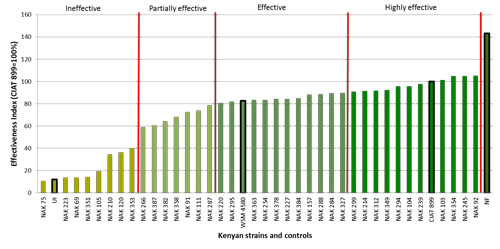Phaseolus vulgaris (common bean) is an important food crop in many parts of Africa. Its yield is often hampered by nitrogen deficiency in soils despite its ability to nodulate and fix nitrogen with a wide range of rhizobia. Bean inoculation programs in Africa have repeatedly been plagued by a lack of, or erratic, inoculation responses in the field and my study aims to understand this phenomenon by 1) collecting, identifying and screening indigenous/naturalized rhizobial populations in Kenyan soils for effectiveness on commercially important bean cultivars alongside elite inoculant strains, 2) exploring possible causes of differences in strain effectiveness, mainly the role of poly-3-hydroxybutyrate, 3) evaluating the competiveness of these stains in multi-strain environments with the aid of reporter genes and 4) evaluating the effect of soil nutrients on nodule occupancies and nitrogen fixation outcomes.
|
Over 300 isolates were obtained from both cultivated and wild legumes growing in different agro ecological zones in Kenya. The isolates were authenticated and screened for effectiveness on commercially important Kenyan bean cultivars in sterile pot systems revealing a wide range of effectiveness. Effectiveness Index was calculated based on strain performance in comparison to the inoculant strain used in Kenya CIAT 899. Figure 1 shows the effectiveness index for some of the Kenyan isolates. |
Figure 1: Effectiveness Index of Kenyan strains on P. vulgaris ‘KK08 ‘ in sterile pot system. Bars of control treatments bolded |
The data shows that there are a number of strains in Kenyan soils of comparable effectiveness to CIAT 899. Focus is now on the competitiveness of these isolates. The hypothesis is that the native strains will be more competitive than the commercial strains on Kenyan bean cultivars either by, the Kenyan bean cultivars having a higher affinity for the native strains and or, the native strains being more adaptable to Kenyan soil conditions. Competition studies are being undertaken with the aid of gusA and celB marker genes.
The role of poly-3-hydroxybutyrate (PHB) in bean bacteriods is also being investigated. PHB is thought to be accumulated by N2 fixing bacteroids as a means of hoarding carbon that is supplied by the plant leading to suboptimal N2 fixation. The wide range of strains with different N2 fixing abilities is being used to explore this area.
George Mwenda 2nd Year PhD student at Murdoch University, supervised by Graham O’Hara, Jason Terpolilli, John Howieson and Nancy Karanja
*George also made his research poster available that was presented in a poster contest at Murdoch University.

